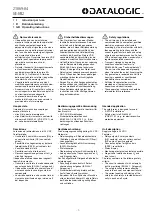
CMSRD15 Rev A
022120
10
5.5.4 Inspect the Cable: The SRD lifeline is steel cable, and subject to certain hazards. Inspect the lifeline before each use for the
conditions as described in Section 7.
5.6 Using the SRD: Do not use the SRD if inspection shows damage or any malfunction. Don the FBH in accordance with the FBH
manufacturer’s instructions. Follow the instructions contained in this manual and on the labels. Failure to follow instructions may result
in serious injury or death. Connect the leg end carabiner to the dorsal D-ring on the FBH. Ensure the carabiner closes and locks. Attach the
housing carabiner to the chosen anchorage and ensure the carabiner closes and locks. Ensure all connections are compatible.
Normal operation will allow the working length of the lifeline to extend and retract as the worker moves about. A certain amount of
tension must remain on the cable at all times to ensure proper operation of the internal brake. Do not allow the lifeline to become slack.
If the lifeline becomes slack, remove the SRD from service for inspection. See Section 7.
Avoid sudden or quick movements during the normal work operation, as this may cause the SRD brake to engage and possibly cause loss
of balance and injury or death.
If a fall occurs, the brake will engage and lock the lifeline to arrest the fall and limit arrest forces on the user.
•
DO NOT extend the lifeline past the operational limit.
•
DO NOT allow one SRD lifeline to become tangled or twisted with another SRD lifeline during use.
•
DO NOT allow any lifeline to pass under arms or between legs during use.
•
DO NOT clamp, knot, or prevent the lifeline from retracting or being taut.
•
DO NOT lengthen the SRD by connecting a lifeline or similar component.
•
DO NOT allow the lifeline to remain outside the housing when not in use.
•
DO NOT allow the lifeline to freewheel back into the housing. Use a tag line to maintain tension and rewind the
lifeline during periods of inactivity. Use the tag line to retrieve the leg end connector for the next use.
•
DO NOT leave the tag line connected to the leg end connector when using the SRD for fall protection.
5.7 After A Fall: A fall event over an edge may require special rescue equipment and measures. Ensure a written rescue plan, method and
system is in place and readily available to all users for rapid response. Ensure all users are trained in rescue procedures. If a fall event
occurs, remove it from service, and store it separately. Remove from service any unit that has been subjected to fall arrest forces or that
exhibits damage consistent with such forces. For questions, contact FallTech.
6.0 Maintenance, Service and Storage
6.1 Maintenance: Ensure the SRD is kept free of excess paint, grease, dirt, or other contaminants as this may cause to cable or retracting
mechanism to malfunction. Ensure no debris enters the housing through the cable access port. Clean the exterior of the unit as required
with a detergent/water solution. Do not allow water other corrosion causing elements to enter the housing. After cleaning, pull the
lifeline all the way out, allow the unit to air dry, then retract the lifeline into the unit. Do not allow the lifeline to freewheel back into the
housing. Clean labels as required.
DO NOT use heat to dry.
DO NOT attempt to disassemble the SRD.
6.2 Service: If service is required for any reason; inspection failure, impact loaded, any type of malfunction, tag the unit as “UNUSABLE”,
store separately, and remove from service. The SRD is not user repairable. Only the manufacturer, or a repair facility authorized in writing,
may make repairs to the SRD.
6.3 Storage: Hang the SRD in a cool, dry, clean environment out of direct sunlight. Position the SRD so excess water can drain out. Avoid
exposure to chemical or caustic vapors. Thoroughly inspect the SRD after any period of extended storage.











































